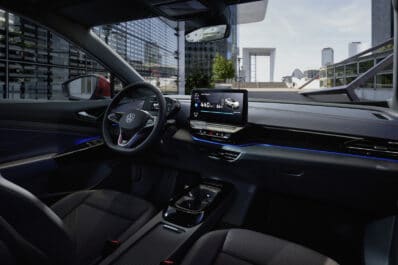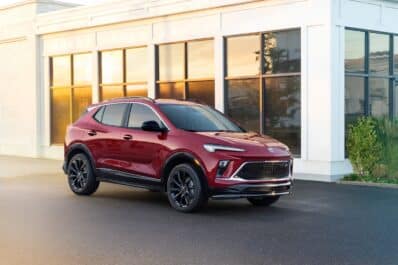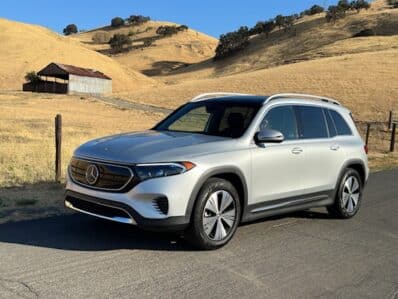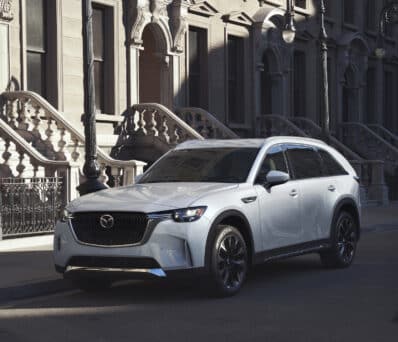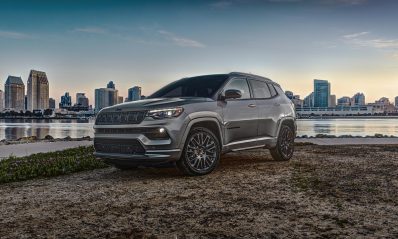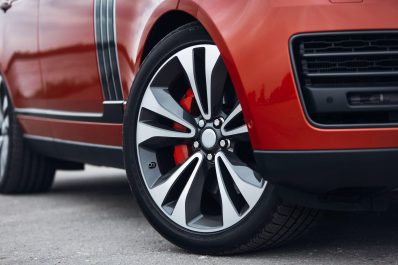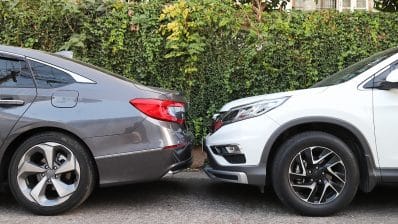
There’s no question that Tesla dominates the battery-electric vehicle market. Until now, only the Chevrolet Bolt EV has come close to getting the California upstart any sort of challenge.
But Tesla’s grip is starting to weaken. Its share of the U.S. BEV market slipped from an astounding 81% to 69% last month, reports widely followed analyst Adam Jonas of Morgan Stanley, and it’s heading downward. According to Jonas, the slide is due almost entirely to one new competitor: the Ford Mustang Mach-E.
TheDetroitBureau.com offered up a preliminary review of the Mach-E in December, focusing on a two-day drive of the base, single-motor version of the battery-powered car. We’ve now had a chance to spend a full week behind the wheel of the Premium model which, with twin motors and an estimated 305 miles per charge, is what most buyers are expected to purchase. We’ll follow up with the top-line Mustang Mach-E GT when it comes to market later this year.
Overview

While Ford Motor Co. was an early pioneer of electrification, the Mustang Mach-E is not only its first long-range offering but the first Ford BEV to use a skateboard-like platform placing the battery pack and motors below the cabin’s load floor. The layout offers a number of advantages in terms of cabin and cargo space, while also lowering the crossover’s center of gravity, enhancing road dynamics.
The Mach-E marks the first time Ford has ever used the Mustang badge on any product other than the familiar sports coupe. To push the boundaries even further, the battery-electric car uses a coupe-crossover body design.
That’s created controversy among traditionalists. But Ford’s seemingly risky bet appears to be paying off in a market where SUVs and CUVs have come to dominate. Early buyers appear to like the higher seating position, the added cabin space and the overall look and feel of the Mach-E.
There will be three primary versions available by the second half of 2021. These include a base, rear-drive model offering a choice of 68 or 88 kilowatt-hour battery packs, the twin-motor all-wheel-drive version we drove for this review, and the sportiest Mustang Mach-E GT.

The Mach-E is one of the first new entries in what will soon be a wave of BEV options coming from brands as diverse as Alfa Romeo and Cadillac to Volkswagen and Volvo. Ford’s entry directly targets the popular Tesla Model Y.
Exterior
Talk to members of Team Edison, the internal group Ford’s tasked with developing its new offering, and you realize the challenges they faced. Tinkering with an icon is never easy. That was all the more so when turning the familiar pony car into an SUV — and then powering it with batteries.
As I noted in my original review, they did a solid job. The new battery car picks up a number of key design cues, including the sequentially flashing rear taillights and what, at first glance, appears to be a steeply raked roofline. But there is, as the art community would put it, plenty of trompe l’oeil elements clearly meant to fool the eye. The most significant is the two tier, two-tone roof that manages to make the overall cabin seem lower and sleeker without sacrificing interior space.
Another unusual touch is the “E-Latch” system. Tap a touch-sensing button and the front doors can be opened using small grab hooks. The rear doors, in turn, “present” themselves, popping out a couple inches to let you grab and open them.
On the whole, all three versions of the Mach-E will look similar. The most notable change comes with the use of a three-

dimensional textured grille on the GT. The reality is that grilles are largely ornamental on BEVs which don’t need to feed or cool internal combustion engines.
Interior
Perhaps the first thing you’ll notice when you climb into the Mustang Mach-E is just how much room it offers, both front and back, as well as in the cargo bay. No more 2+2 requiring you to apologize to anyone stuck in the rear seats. And the two-tier rough design translates into plenty of headroom, even someone with my 6’2” height.
All told, there’s 29.7 cubic feet of cargo space, jumping to 59.7 cf with the back tow folded down. If that’s not enough, there’s a a roomy “frunk” under the hood big enough for a small roller bag — and sealed so a motorist could load up with ice and beverages for a tailgate party, with a drain at its base, of course.

The cabin features a cleanly minimalist look while paying homage to the double-cowl layout of the classic Mustang. There’s one thing that you won’t find in the coupe: plenty of storage, the floating, flip-up armrest concealing space large enough for a purse or bag. The design emphasizes Mach-E’s high-tech features. There’s a floating screen visible through the steering wheel replacing a conventional gauge cluster. The layout and colors change when you switch between the various driving modes.
Virtually all other displays, knobs and switches have been replaced by a portrait-oriented, 15.5-inch, portrait-oriented touchscreen that dominates the instrument panel. Conceptually, it resembles what Tesla uses in its various models though it seems a bit easier to get familiar with. The system runs a modified version of Ford’s new Sync 4 infotainment system. The Mach-E screen can be operated much like a smartphone, with taps, swipes and punches – or using verbal commands. It is nearly as good at responding to natural-speech as voice assistants like Amazon’s Alexa.
The system also offers a variety of special functions designed specifically for the EV, among other things, helping a motorist plan a route telling you where to stop and charge along the way.
Powertrain

By late this year, buyers will have a variety of Mustang Mach-E variants to choose from:
- The base model using a single motor on the back axle and the standard-range, 68 kWh battery makes 266 hp and 317 lb-ft. With the long-range 88 kWh battery that jumps to 290 hp and 317 lb-ft;
- The mid-range model adds a second motor on the front axle to create an all-wheel-drive system. With the smaller battery it generates 266 hp and 428 lb-ft, while that rises to 346 hp and 428 lb-ft with the long-range pack; and
- Set to debut later this year, the Mach-E GT uses the same, high-performance motor on both axles while also adding torque vectoring. While we’re waiting for final specs they’re expected to run around 459 hp and 612 lb-ft, with a GT Performance option at around 480 hp and 634 lb-ft.
I spent several days in the base model for my original review in December. This time, however, I had the chance to drive the mid-range package — which is expected to be the most popular option. It came with the 88 kWh battery pack which is EPA-rated at 305 miles per charge. That said, the classic caveat, “mileage may vary,” should be an EV buyer’s mantra.
My personal experience — echoed by research from AAA, Consumer Reports and others — is that BEV range varies even more than a gas-powered vehicle. And it will be influenced by factors you might not have considered before. Obviously, the more aggressive your driving, the more range you’ll sacrifice. On the other hand, stop-and-go conditions actually can benefit range, as hybrid drivers long ago learned. That’s because BEVs and

HEVs use regenerative brakes capable of recapturing energy normally lost during braking and coasting, sending it back to the battery pack.
Another factor to consider is weather. Cabin heating sucks down power because you don’t have the waste heat of an internal combustion engine to keep you warm. I’ve generally found that BEVs lose about 40% of their stated range when you get down to 20 degrees Fahrenheit. The AAA and CR have published similar results.
Depending upon when, where and how I drove over the course of a week, I found I was averaging between 260 and 280 miles of range. Considering the cool weather and my heavy right foot, I was not disappointed.
Mach-E uses a 400-volt electrical architecture allowing users to go from a 10% state of charge to 80% in just 45 minutes at the newest Level 3 public quick-charging stations. In our test, using an Electrify America charger, we beat that time by about 7 minutes. Using a 240-volt charger is a roughly overnight affair and the precise time depends upon how much current you put into the pack. Charging on 120 volts isn’t recommended and likely will yield barely 3 additional miles an hour.
Technology and Safety
Ford largely mirrors the approach taken by Tesla, letting its big touchscreen anchor vehicle operations. There are a small

handful of traditional controls, including those on the steering wheel. And the Mach-E has an effective voice control system that recognizes common speech, rather than requiring you to learn oft-quirky commands. But that screen is your primary interface with the car.
That starts with the Phone-as-Key system. It lets you leave the keyfob at home and use your smartphone instead. The vehicle knows a lot about you and automatically retrieves personal settings such as seat and mirror positions, audio and climate control choices. Meanwhile, you can provide additional digital keys to friends and family.
The Ford app, meanwhile, allows you to remotely start the car and, if it’s hooked up to a charger, pre-condition the cabin so you don’t waste battery power heating or cooling it up after taking off. You can trigger charging instantly, or set the time you prefer. That’s useful if connected to a home charger that gets discounted energy at a particular time of day.
You can pre-select a destination and upload it to your Mach-E. The Sync system will not just plot out a route but even lay out recommendations for where to stop and recharge, if necessary, along the way.
For audiophiles, the Mach-E offers an upgraded Bang & Olufson sound system with speakers that appear to float inside the cabin.
As you’d expect, the Mach-E comes with an extended array of advanced driver assistance systems, such

as forward collision warning with automatic emergency braking and blind-spot warning.
The electric Mustang is the first Ford to permit essentially all of its onboard software to be updated over-the-air, smartphone style. Expect to see that used for fixes – today, almost half of all recalls are software related. But Ford also plans to use the system to update and add new features. Next year that will include its new hands-free Active Drive Assist system – Ford’s answer to the Tesla Autopilot. Eventually, it may also offer the ability to purchase new functions or download entertainment.
Drive Impressions
One of the most exciting parts of driving a current-generation EV is the performance it delivers. That’s because electric motors deliver their maximum, tire-spinning torque the moment they start turning. No waiting for a gas engine to rev up — a particular problem with most modern turbo packages. Even the base Mustang Mach-E delivers a surprising amount of off-the-line punch. And with the mid-line, AWD model, you’ll hit 60 in around 4.5 seconds, making this version of the Mach-E quicker than a comparable Porsche Macan.

Slam on the throttle and you immediately sink into your seat, and the sense of thrust continues right up through freeway speeds. Along the way you might notice the absence of any shifts, as the Mach-E — like most current BEVs — relies on a single-speed transmission.
While the mid-range Mach-E doesn’t offer the torque vectoring Ford plans to add to the GT line, it still as a nimble and sure-footed feel to it. This is not a lightweight vehicle. With the extended battery option it will push upwards of 4,900 pounds.
It helps to have the pack mounted so low. That minimizes body roll and helps manage the crossover in corners. But don’t expect this to drive like a classic Mustang coupe. It won’t. But it seems to have better manners than a number of other BEVs I have driven of late, including the new Chevrolet Bolt EUV and Volkswagen ID.4.
My colleague, TDB’s Managing Editor Michael Strong, has spent more time than I have in the Tesla Model Y — driving the Model Y Performance last fall — and feels the Mustang Mach-E’s drive dynamics are better in all key aspects. It offers a smoother ride, especially on Michigan’s notoriously bad roads, and it handles better than Tesla’s small CUV.
One thing I was personally happy to discover was the way Ford has tweaked the brakes on the Mach-E I had for a week. With the original, single-motor tester I drove in December, they were grabby and hard to modulate. Not so the new model. The brake system, meanwhile, can be set to increased “Regen” mode, upping the amount of power pulled back into the battery when braking and coasting. The added advantage is being able to “One-Pedal Drive.” In many situations, you can simply ease up on the throttle without having to tap the brakes to slow down. This is particularly useful in traffic.
Wrap Up
When work began on a long-range electric vehicle, Ford started out working up a bland and boring product that likely would have been dead on arrival. Luckily, senior management rethought that strategy and sent the development team back to their digital drawing boards. Good thing. The 2021 Ford Mustang Mach-E is pretty much spot on, delivering all the things that you would expect from a vehicle sharing the pony car’s badge.
Preliminary sales numbers suggest there’s a real market for a BEV like the Mach-E – as analyst Jonas recently noted. Initial sales, if anything, have been slow due to production challenges. Ford has delayed many deliveries due to extensive quality checks, so you may have to wait if you’re ready to place an order. But it will be worth it if the automaker can avoid the problems that it had with several other recent product launches.
The base, single-motor Ford Mustang Mach-E comes in at $43,995 to start. The two-motor at $46,695. Add to that options and you’ll be pushing into $50,000 territory. The good news is that, unlike GM and Tesla, Ford buyers still can access federal tax credits of up to $7,500. That only enhances its appeal compared to the Model Y.






